人教版高中英语必修五:Unit+1教案-1+
人教版高中英语必修五Unit 1 Great Scientists Period 1 Reading教学设计教案
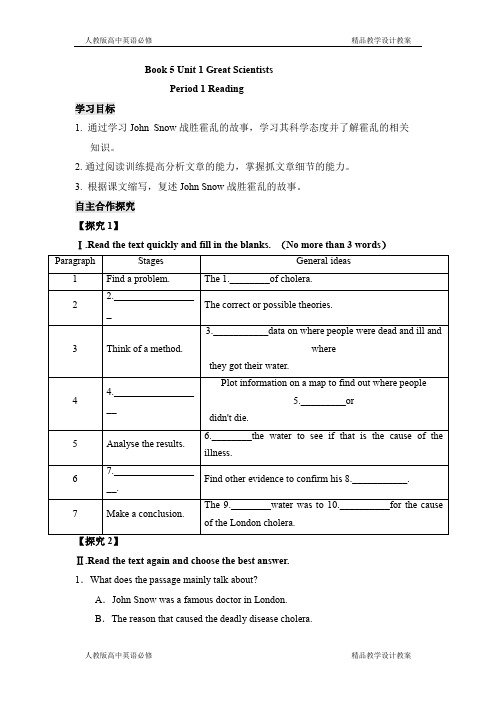
Book 5 Unit 1 Great ScientistsPeriod 1 Reading学习目标1. 通过学习John Snow战胜霍乱的故事,学习其科学态度并了解霍乱的相关知识。
2. 通过阅读训练提高分析文章的能力,掌握抓文章细节的能力。
3. 根据课文缩写,复述John Snow战胜霍乱的故事。
自主合作探究【探究1】Ⅰ.Read the text quickly and fill in the blanks. (No more than 3 words)Ⅱ.Read the text again and choose the best answer.1.What does the passage mainly talk about?A.John Snow was a famous doctor in London.B.The reason that caused the deadly disease cholera.C.John Snow solved the problem of cholera.2.Which of the following theories did John Snow believe in?A.A cloud of dangerous gas would float around until it found its victims.B.People absorbed cholera into their bodies with their meals.C.People got infected with cholera because of cold and hunger.3.Before 1854,when cholera broke out,________.A.many thousands of people died B.people with cholera could be cured C.John Snow began to know its cause4.How did he find out the cause of the disease?A.By living in the area where cholera broke out.B.By marking a map where all the dead people had lived.C.By telling the terrified people how to prevent it.5.What do you think the Londoners would do with the unused pumps after defeating “King Cholera”?A.They would destroy them.B.They would reuse them after cleaning. C.They would desert them for ever.【探究3】III. Recite the following sentences1.John Snow was a famous doctor in London-so expert,indeed,that he attended Queen Victoria as her personal physician.约翰·斯诺是伦敦一位著名的医生—他的确医术精湛,因而成了维多利亚女王的私人大夫。
必修五Unit1-教案
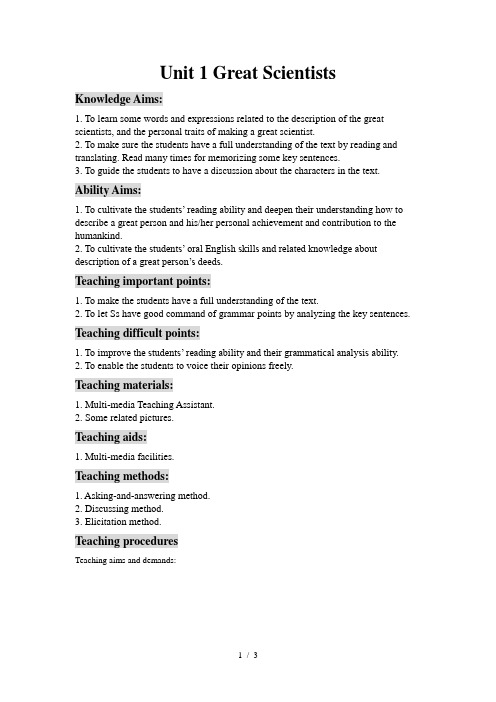
Unit 1 Great ScientistsKnowledge Aims:1. To learn some words and expressions related to the description of the great scientists, and the personal traits of making a great scientist.2. To make sure the students have a full understanding of the text by reading and translating. Read many times for memorizing some key sentences.3. To guide the students to have a discussion about the characters in the text. Ability Aims:1. To cultivate the students’ reading ability and deepen their understanding how to describe a great person and his/her personal achievement and contribution to the humankind.2. To cultivate the students’ oral English skills and related knowledge about description of a great person’s deeds.Teaching important points:1. To make the students have a full understanding of the text.2. To let Ss have good command of grammar points by analyzing the key sentences. Teaching difficult points:1. To improve the students’ reading ability and their grammatical analysis ability.2. To enable the students to voice their opinions freely.Teaching materials:1. Multi-media Teaching Assistant.2. Some related pictures.Teaching aids:1. Multi-media facilities.Teaching methods:1. Asking-and-answering method.2. Discussing method.3. Elicitation method.Teaching proceduresTeaching aims and demands:Teach proceduresStep 1 warming upShow some pictures of the famous scientists and ask the Ss to answer the following question:1.Do you know those scientists?(Ss say some scientists. Such as : Albert Einstein\, Isaac Newton, Benjamin Franklin(1706-1790, Qian Xuesen , Liu Zhenxing , Hawking, Mendeleev……)Ask the Ss some to introduce some scientists by his / her own word by the next question2.Can you remember their names and their scientific achievements?.Help the Ss to finish the introduction.Step 3. Pre-readingAsk the Ss the following Qs”3. What do you know about infectious diseases such as cholera ?4.Do you know how to prove a new idea in scientific research? (Ask the Ss to guess the correct orders of the steps on page)Step4. ScanningRead the passage quickly and put the correct stages into the reading about research into a disease.Find a problem: John Snow was a well-known doctor in London…until its cause was found.Make up a question: He got interested in the two theories…and soon the affected person was dead.Think of a method: He believed in the second theory but…so severe that more than 500 people had died in 10 days.Collect results: He determined to find out why… It seemed the water was to blame.Analyze the results: Next, John Snow looked into the source of the water for these two streets…that cholera wa s spread by germs and not in a cloud of gas.Repeat if necessary:In addition, he found…that polluted water carried the disease. Draw a conclusion: To prevent this from happening again, …not to expose people to polluted water anymore.Step 5. Careful reading1.Ask the Ss to read the text carefully and then finish the chart in Ex. 1 on page 3. Scientific Report by John SnowThe problem Nobody knew the cause of the serious diseaseof cholera.The cause Idea 1: strange cloud in the air that attacked victims.Idea 2: people absorbed the disease with their meals.The method Collect data from the next cholera attack to test theories. Try to prove which method was correct.The results He found the cause of cholera was the polluted water.Idea 1 or 2? Why?Idea 2. Because the data showed a connection with the water.The conclusion John Snow was able to defeat cholera once its cause was known.Step 6. Further Discussion1.Cholera was a 19th century disease. What disease do you think is similar to cholera today? Why?2.Two diseases, which are similar today, are SARS and AIDS because they are both very serious, have an unknown cause and need public health care to solve them.。
人教版高中英语必修五Unit1-PeriodⅢ
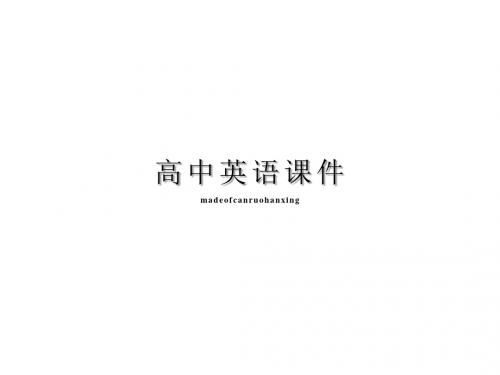
life(time/efforts/energy...)to(doing)sth.以及 be devoted to 结
devote 构,表示“献身于/致力于某一事业或目标”
当 堂
方
案
。
双 基
设
达
计
标
菜单
新课标 ·英语 必修5
教
学
目 标
完成句子
分
析
①I'm sure your suggestion will
堂 双
案
基
设 句意。
达
计
标
【答案】 B
菜单
新课标 ·英语 必修5
3.apart from除……之外;此外
教 学
Apart from the construction mentioned above,you have
课
目
堂
标 分
also learned the following phrases.(教材P4)
学
方 结构。
堂 双
案
基
设
达
计
标
菜单
新课标 ·英语 必修5
The construction of a large bridge takes about two years.一
教 学
座大型桥梁的建设花费大约两年时间。
课
目
堂
标 分
This construction will be used to store farm equipment.
当 堂
方
双
案 设
the injuries to his face and hands,he broke both his legs.
高中英语必修五Unit1教案
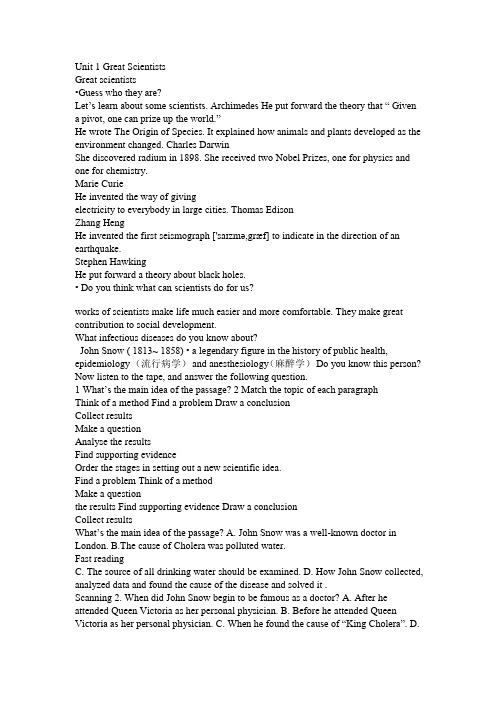
Unit 1 Great ScientistsGreat scientists•Guess who they are?Let’s learn about some scientists. Archimedes He put forward the theory that “ Given a pivot, one can prize up the world.”He wrote The Origin of Species. It explained how animals and plants developed as the environment changed. Charles DarwinShe discovered radium in 1898. She received two Nobel Prizes, one for physics and one for chemistry.Marie CurieHe invented the way of givingelectricity to everybody in large cities. Thomas EdisonZhang HengHe invented the first seismograph ['saɪzmə,græf] to indicate in the direction of an earthquake.Stephen HawkingHe put forward a theory about black holes.• Do you think what can scientists do for us?works of scientists make life much easier and more comfortable. They make great contribution to social development.What infectious diseases do you know about?John Snow ( 1813~ 1858) • a legendary figure in the history of public health, epidemiology (流行病学)and anesthesiology(麻醉学)Do you know this person? Now listen to the tape, and answer the following question.1 What’s the main idea of the passage?2 Match the topic of each paragraphThink of a method Find a problem Draw a conclusionCollect resultsMake a questionAnalyse the resultsFind supporting evidenceOrder the stages in setting out a new scientific idea.Find a problem Think of a methodMake a questionthe results Find supporting evidence Draw a conclusionCollect resultsWhat’s the main idea of the passage? A. John Snow was a well-known doctor in London. B.The cause of Cholera was polluted water.Fast readingC. The source of all drinking water should be examined.D. How John Snow collected, analyzed data and found the cause of the disease and solved it .Scanning 2. When did John Snow begin to be famous as a doctor? A. After he attended Queen Victoria as her personal physician. B. Before he attended Queen Victoria as her personal physician. C. When he found the cause of “King Cholera”. D.After he defeated “King Cholera”.Scanning3. Some people thought that cholera spread _____ before John Snow found its cause.A. in the airB. by the beerC. in the waterD. by the birdsScanning4. What played an important role in John Snow’s discovery?A. The woman moving away from Broad Street.B. The government.C. The map made by himself.D. Queen Victoria’s help.Scanning 5. At last, “King Cholera” was brought under control by ____.A. using medicines in hospitalsB. driving patients out of the countryC. dealing with the polluted waterD. getting rid of all kinds of pollution6. Which of the following is TRUE?A. John Snow became famous after cholera hit England in the 19th century. B. John Snow began to collect information long before cholera hit England in the 19th century. C. The mother and her daughter mentioned in the text both lived in Broad Street. D. D John。
人教版高中英语必修5_unit_1_单词讲解
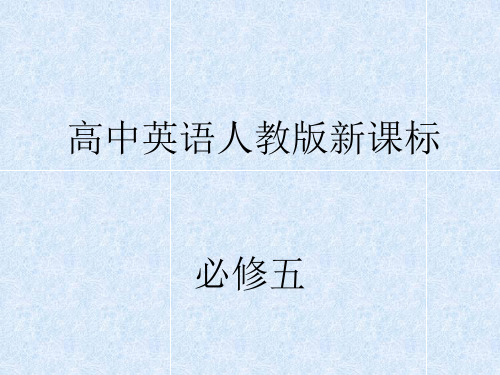
10. expose vt. 暴露,揭露, 使曝光 expose crime揭露罪行 expose the truth揭露真相 • expose sth./sb./oneself (to...) 暴露某事物/某 人/自己(给……) expose sb/sth 揭发某人/某事 be exposed to 暴露 expose…to…“把……暴露于……之下(之中), 使……受到……作用” expose a child to books exposed adj. 暴露的,暴露于风雨中的,无掩蔽的 exposure n. [u]暴露;揭露,揭发 expose one’s skin to the sun 使皮肤暴露于阳光下
• take part in 指参加会议或群众性活动等, 着重说明句子主语参加该项活动并在活动中 发挥积极作用。 • We'll take part in social practice during the summer vacation. 暑假期间我们将参加社 会实践。 • take part in是惯用词组,part前一般不用冠 词,但part前有形容词修饰时,要用不定冠 词。Lincoln took an active part in polities and was strongly against slavery. 林肯积极 参加政治活动,强烈反对奴隶制。
vt. 治愈;治疗
curable adj. 可治愈的 a cure for... 针对……的治疗 cure sb. of sth. 改正某人的坏习惯;治愈某人的疾病
• 区别cure/treat/heal (1)treat指通过药物、特别的食品或运动治病,强 调治疗过程,不一定治好。
• treat sb. for sth.医治某人的病;还可作“对 待,看待”讲,treat...as把……看作/视为。 (2)cure意为“治愈,痊愈”,特别指病后的恢
高中英语《必修五第一单元单元词汇课》优质课教案、教学设计

教案设计(Learning about Language)部分由“词汇学习”和“语法学习”两项内容组成。
“词汇学习” 部分练习1 通过词的后缀训练名词与形容词之间的相互转换提倡学生使用词典。
练习2 选词填空练习,利用语篇集中训练本单元的一些重点词汇的用法。
练习3 是单句填空,而且所选的十个句子或是引文或是谚语。
“语法学习”部分主要是帮助学生了解、熟悉并掌握情态动词的用法,共有三项练习。
“语言运用”(Using Language)部分主要是让学生运用本单元所学的语言知识与课文内容进行听、说、读、写等的综合训练。
“听与说” (Listening and speaking); 是听前准备活动。
“读与写”(Reading and writing)主要设计是:阅读内容主要讲述一位来自高中的学生对全球变暖十分关注并向地球保护协会写了一封信询问措施。
协会给出了相当令人满意的回信。
短文后的三个问题帮助学生理解文章的内容。
写信的部分主要是要求学生根据上面阅读文章的内容通过思考写出自己的思想、自己的做法,尝试解决问题的不同途径。
教材提供给学生一些写作时要思考的问题,帮助学生完成写作构思。
“小结”(S ummin g U p)部分让学生根据所给出的提示对所学各项内容进行总结。
“学习建议”(L e a r nin g T ip)部分主要建议学生看阅读报纸,多读书多总结,以培养学生运用语言资源的能力。
五、教学重点Teaching important pointsa.The usage of language points of this unit.b.To learn to use these words.教学难点Teaching difficult pointsa.Enable students to get the hang of the language points completely.b.Get students to discuss warmly and express their own and excellent idea.教学方法Teaching methodsa.Brainstormingb.Task based language teaching.c.Individual, pair or group work to finish each task.d.Discussion.教学过程:1.concludevi.推断出vt.结束①conclude 推断出;断定conclude...with... 以...结束conclusion n .结论;结束arrive at/come to/reach/draw a conclusion 得出结论in conclusion 总而言之学生去说;学生能做的教师就不要代替学生去做;学生回答问题无论对还是错,教师不要急于评判,让学生自已去评判与总结;对发言积极的学生要及时鼓励,决不能因为他们的答案与教师的标准答案不一样就否定并伤害学生的自尊心。
新人教版高中英语必修5《Unit 1 Great scientists 》精品
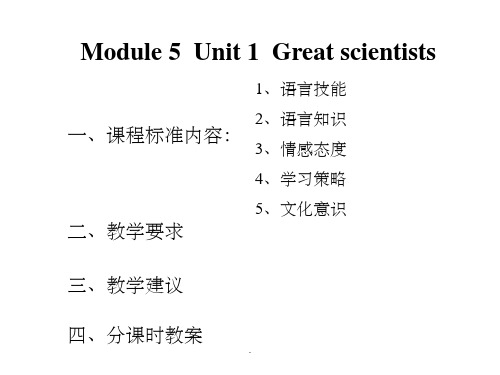
三、本单元教学建议
热身(Warming up)部分在学生课前预习的基础上,教 师可利用图片资料引入,也可以让学生讲述某位科学家的 故事或成就让其他学生来猜测,但讲述内容不宜过长。
读前(Pre-reading)部分建议呈现有关SARS和AIDS宣传 图片或视频资料,引导学生关注疾病与健康,然后再引出 cholera。可以分若干个讨论小组讨论如何进行科学研究, 让学生了解科学观点的形成过程。
.
三、本单元教学建议
语言学习(Learning about language)部分Exercise 1是用所 给词的正确形式填空。教师应确定学生了解这些词的意思 和用法。Exercise 2是一个拓展练习,要求学生掌握make+ 名词,在意义上等于这个名词的动词形式,例如:make a speech=speak。Exercise 3进一步训练动词make的用法。教 师 还 可 以 鼓 励 学 生 回 忆 更 多 的 有 关 于 make 的 用 法 。 Discovering useful structures是语法知识教学,教师可引导 学生在Reading中找到更多过去分词作定语和表语的用法。 Exercise 1、2&3帮助学生感知过去分词作定语和表语,并 逐步过渡到巩固和运用这种语言现象。
.
学习策略 :
通过周密观察、认真分析等、自助、自悟能力,以培 养学生调控策略;利用网络等媒体获取相关知 识来提高资源策略;通过交流表达观点来提高 运用交际策略的能力。
文化意识:
了解许多中外科学家的事迹及他们的贡献,扩 大知识面;以知识武装头脑,以文化陶冶情操。
.
Warming Up:
There are some great scientific achievements that have changed the world. Can you name some of them? What kind of role do they play in the field of science ? Do these achievements have anything in common? Match the inventions with their inventors below before you answer all these questions.
人教版英语必修五Unit 1(John Snow defeats_King Cholera)教学教案
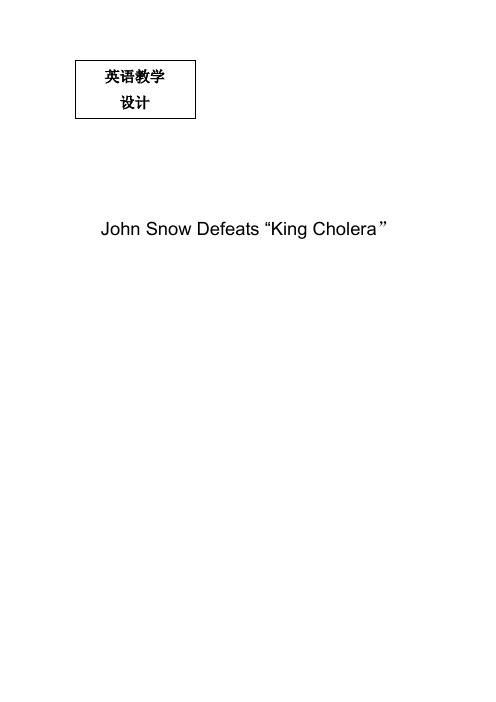
John Snow Defeats “King Cholera”Unit 1 John Snow Defeats “King Cholera”Teaching Goals:1. Enable the Ss to get to know some knowledge about Cholera.2. Enable the Ss to understand the passage well.3. Let the Ss learn some reading skills by scanning and skimming.4. To learn from the great scientists and develop the noble spirits . key points:1. To train the reading skills of skimming, scanning and careful reading;2. To master the details of the passage and appreciate the spirits of the scientists.Difficult points1. To develop the students’ ability of grasping the main idea of each paragraph.2. To get some detailed information by reading the text. Teaching methods1. Skimming & scanning2. Discussion methods3. Pair work of group4. CompetitionTeaching process:Step 1 Lead in本单元标题是伟大的科学家。
所以活动的设置为让学生说出自己熟知的科学家姓名、其发明、工作、生活的情况。
高中英语Unit 1 Great scientists 人教版必修五
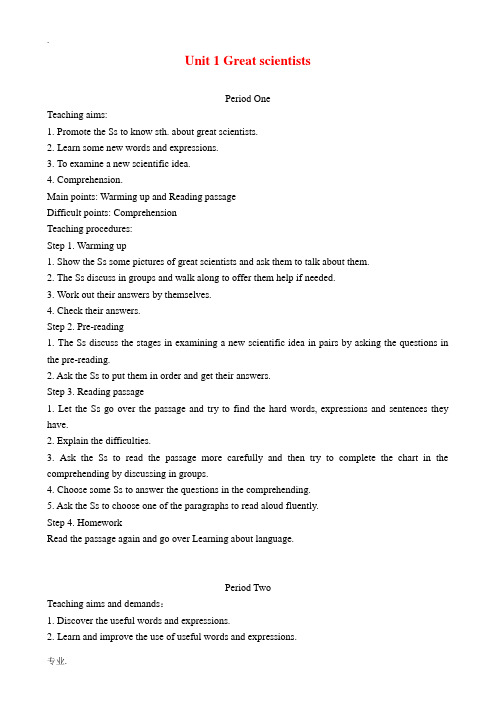
Unit 1 Great scientistsPeriod OneTeaching aims:1. Promote the Ss to know sth. about great scientists.2. Learn some new words and expressions.3. To examine a new scientific idea.4. Comprehension.Main points: Warming up and Reading passageDifficult points: ComprehensionTeaching procedures:Step 1. Warming up1. Show the Ss some pictures of great scientists and ask them to talk about them.2. The Ss discuss in groups and walk along to offer them help if needed.3. Work out their answers by themselves.4. Check their answers.Step 2. Pre-reading1. The Ss discuss the stages in examining a new scientific idea in pairs by asking the questions in the pre-reading.2. Ask the Ss to put them in order and get their answers.Step 3. Reading passage1. Let the Ss go over the passage and try to find the hard words, expressions and sentences they have.2. Explain the difficulties.3. Ask the Ss to read the passage more carefully and then try to complete the chart in the comprehending by discussing in groups.4. Choose some Ss to answer the questions in the comprehending.5. Ask the Ss to choose one of the paragraphs to read aloud fluently.Step 4. HomeworkRead the passage again and go over Learning about language.Period TwoTeaching aims and demands:1. Discover the useful words and expressions.2. Learn and improve the use of useful words and expressions.Main points: Learn to use the words and expressions that the Ss discover.Difficult points: Improve the use of the words and expressions.Teaching procedures:Step 1. Learning about language1. Discover the useful words and expressions in this unit in groups of four.2. Ask the Ss to show their results to the class.3. Ask them to study the words and expressions in Ex.1.4. Ss have a discussion and do the exercises.5. Check their answers.6. Change the verbs into nouns and make sentences by using “make a …〞Step 2. Using words and expressions1. Make sure the Ss know the words and expressions.2. Let the Ss work in groups to complete the blank in Ex.1.3. Check their answers.4. Do the translations. Ss discuss the sentences and the translate them into English, using the words and phrases in brackets.Step 3. Words learning1. Show the Ss a list of prefixes to talk about them.2. Ask them to work in groups to find some words with the prefixes and study their meanings.3. Let them show their results to the class.4. Walk around the class to give them help if needed.Step 4. Study the use and meanings of suggest1. Study the meaning of suggest by looking the dictionary entry.2. Match the meanings with the sentences on the right in Ex.4.3. Check their answers.Step 5. HomeworkTeaching aims and demands:1. Discover the useful structure.2. Learn to use the grammar of past participle.3. Enable the Ss understand the past participle using as attribute and predicative.Main points: Learn the usage of the past participle using as attribute and predicative.Difficult points: Use the useful structure.Teaching procedures:Step 1. RevisionReview the past participle of some verbs.Step 2.1. Look at the chart and study the phrases.Past participle as the attribute and the predicative(1) terrified people(2) reserved seats(3) polluted water(4) a crowded room(5) a pleased winner(6) children who look astonished(7) a vase that is broken(8) a door that is closed(9) the audience who feel tired(10) an animal that is trapped3. Ask the Ss the following questions:(1) What kind of words before the past participles?(2) What kind of words after the past participles?4. Ask the Ss find the sentences using the past participle in the reading passage.5. Ss have a discussion and complete the chart with the same meaning of the phrases above.6. Ss show their results to the class.7. Complete the sentences in Ex.3.Step 3. Using structure1. Make sure the Ss know the words and the discuss in groups to finish the sentences using past participle.(Ex.1)2. Rewrite the sentences into one sentence using the past participle as the attribute or predicative.3. Check their answers.Step 4. HomeworkWrite down 1, 3, 5, 7 of Ex.2 in the exercise book.Period FourTeaching aims and demands:1. Improve the Ss listening skills.2. Know more about great scientists.Main points: Listening and speakingDifficult points: Get to know the information of listening materials.Teaching procedures:Step 1. Listening and speaking1. Listen to the tape and answer the questions.(1) What did Qian Xuesen study first?(2) What experience did he get in America that was very useful for China?(3) What was Qian Xuesen’s achievement when he returned to China from America?(4) How has he been honoured in China?(5) How did Steve honour him?Step 2. Speaking1. Ss discuss what scientific job they will do in the future in pairs by using the questions and expressions on Page 6.2. Ask some Ss to talk in class.Step 3. Listening and talking1. Play the tape for the Ss to listen and finish the exercises in the workbook, pause from time to time if needed.2. Check their answers.3. Work in pairs. Imagine you are going to meet a specialist about a newly-found flower by using the useful sentences on Page 42.Step 4. Listening task1. Play the tape for the Ss to get the information of the listening task.2. Check their answers.Step 5. HomeworkPrepare the reading task.Period FiveTeaching aims and demands:Improve the Ss reading skills and their talent in getting the information.Main points: Reading and reading taskDifficult points: Finding the Euler path.Teaching procedures:Step 1. RevisionRevise the past participle used as the attribute and predicative.Step 2. Reading1. Ss read the passage as fast as they can and then draw the two theories of the universe in groups.2. Ask the Ss to show their pictures to the class.3. Ss read the passage again and find the problems they have.4. Solve the Ss’ problems.5. Discuss in pairs. If you were Nicolaus Copernicus, would you have hidden your theory for so many years? Why?6. Choose some Ss to share their ideas to the class.Step 3. Reading task1. Ss read the passage and answer the following questions.(1) What is odd point? (2) What is even point? (3) What rule did Euler find?2. Ss discuss in groups and try to find the answers.3. Teacher walks around to offer them help.4. Use the rule to see if you can go over the diagram, not missing any points or going over any line twice.( See figures on Page 46)5. Ss work in groups.Step 4. HomeworkWrite a short passage about Copernicus.Period SixTeaching aims and demands:1. Try to write sth persuasive.2. Learn to write a report about people.Main points:Make a plan in discussion.Difficult points:Write a passage / a report.Teaching procedures:Step 1. Writing1.Ask the Ss to read the passage again and gather some information about Copernicus.2. Plan to write a letter.Step 2. Writing taskWrite a report about your scientist, his/her life, achievements and the key to his/her success.1. Before you begin to write, remember to put your information under three headings: life, achievements and key to success.2. Plan your report like the one on P47.3. Ask them to read their plans.4. Begin to write the report.Step 3. HomeworkComplete the report and write down on the exercise book.。
必修五unit1教案

必修五unit1教案教案标题:必修五 Unit 1 教案教学目标:1. 了解并理解本单元的主题和话题;2. 学习并掌握本单元的核心词汇和短语;3. 提高学生的听说读写能力;4. 培养学生的合作与交流能力。
教学重点:1. 掌握本单元的核心词汇和短语;2. 提高学生的听说读写能力。
教学难点:1. 运用所学知识和词汇进行口头和书面表达;2. 培养学生的合作与交流能力。
教学准备:1. 教材:必修五课本 Unit 1;2. 多媒体设备;3. 单词卡片、图片等教具。
教学过程:Step 1:导入(5分钟)1. 利用图片或实物引起学生对本单元主题的兴趣,激发学生的学习欲望;2. 导入本单元的主题和话题,引发学生对话题的思考和讨论。
Step 2:词汇学习(15分钟)1. 呈现并教授本单元的核心词汇和短语,使用各种教具和多媒体设备帮助学生理解和记忆;2. 组织学生进行词汇拓展活动,巩固新学词汇的掌握。
Step 3:听力训练(20分钟)1. 播放录音,让学生进行听力练习,理解对话和文章的主要内容;2. 组织学生进行听力理解的练习,如听后回答问题、听后填空等。
Step 4:口语训练(20分钟)1. 进行口语训练,组织学生进行对话练习,让学生在真实情景中运用所学知识进行口头表达;2. 利用小组活动或角色扮演,提高学生的口语表达能力和合作交流能力。
Step 5:阅读训练(15分钟)1. 学生阅读课文,理解文章的主要内容和细节信息;2. 组织学生进行阅读理解练习,如回答问题、填空等。
Step 6:写作训练(20分钟)1. 引导学生根据所学知识和词汇,进行写作训练,如写一篇关于旅行的短文、写一封邀请信等;2. 指导学生在写作过程中注意语法、词汇和句子结构的正确使用。
Step 7:复习与总结(10分钟)1. 复习本节课所学内容,巩固学生的知识掌握;2. 总结本节课的学习收获,鼓励学生积极参与课堂活动。
Step 8:作业布置(5分钟)布置相关的课后作业,如完成课本练习、写一篇关于旅行的短文、准备下节课的听力材料等。
2021-2022学年高中英语人教版必修五教学案:Unit 1 Section Ⅳ Word版含答案

SectionⅣLearningaboutLanguage&UsingLanguage对应同学用书P15[原文呈现]COPERNICUS' REVOLUTIONARY①THEORYNicolaus Copernicus②was frightened and his mind was confused③. Although he had tried to ignore them, all his mathematical calculations led to④the same conclusion that the earth was not the centre of the solar system⑤. Only if you put the sun there did⑥the movements⑦of the other planets in the sky make sense⑧. Y et he could not tell anyone about his theory as the powerful Christian Church⑨would have punished him for even suggesting such an idea. They believed God had made the world and for that reason⑩the earth was special and must be the centre of the solar system.[读文清障]①revolutionary [ˌrevə'luːʃənərI]adj.革命的;重大变革的②Nicolaus Copernicus ['nIkələs kəʊ'pɜːnIkəs]尼古拉·哥白尼(波兰天文学家)③confused adj.困惑的;苦恼的④lead to通向;导致⑤the solar system太阳系⑥only后接if引导的状语从句,主句使用部分倒装。
必修五 Unit1教案
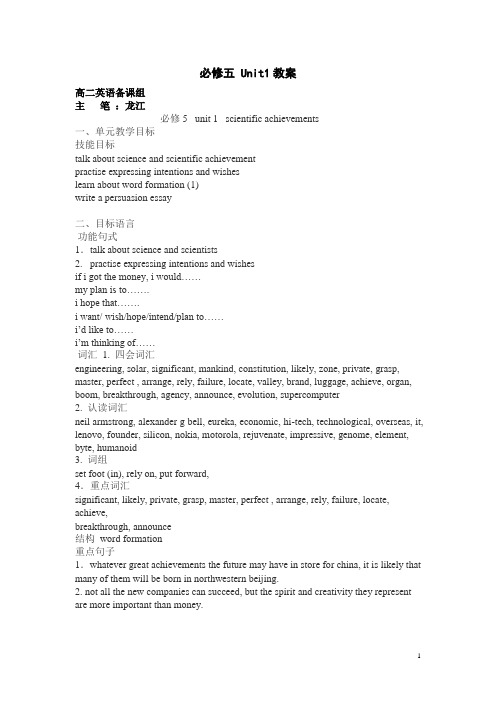
必修五 Unit1教案高二英语备课组主笔:龙江必修5 unit 1 scientific achievements一、单元教学目标技能目标talk about science and scientific achievementpractise expressing intentions and wisheslearn about word formation (1)write a persuasion essay二、目标语言功能句式1.talk about science and scientists2. practise expressing intentions and wishesif i got the money, i would……my plan is to…….i hope that…….i want/ wish/hope/intend/plan to……i’d like to……i’m thinking of……词汇1. 四会词汇engineering, solar, significant, mankind, constitution, likely, zone, private, grasp, master, perfect , arrange, rely, failure, locate, valley, brand, luggage, achieve, organ, boom, breakthrough, agency, announce, evolution, supercomputer2. 认读词汇neil armstrong, alexander g bell, eureka, economic, hi-tech, technological, overseas, it, lenovo, founder, silicon, nokia, motorola, rejuvenate, impressive, genome, element, byte, humanoid3. 词组set foot (in), rely on, put forward,4.重点词汇significant, likely, private, grasp, master, perfect , arrange, rely, failure, locate, achieve,breakthrough, announce结构word formation重点句子1.whatever great achievements the future may have in store for china, it is likely that many of them will be born in northwestern beijing.2. not all the new companies can succeed, but the spirit and creativity they represent are more important than money.三、教材分析与教材重组1. 教材分析通过学习了解人类的科学成就,帮助学生认识到这些成就深刻地改变了人类生产和生活的方式及质量,同时也深刻地改变了人类的思维观念和对世界的认识,改变并继续改变着世界的面貌,极大地推动了社会的发展。
人教版英语必修五 Unit 1 教案
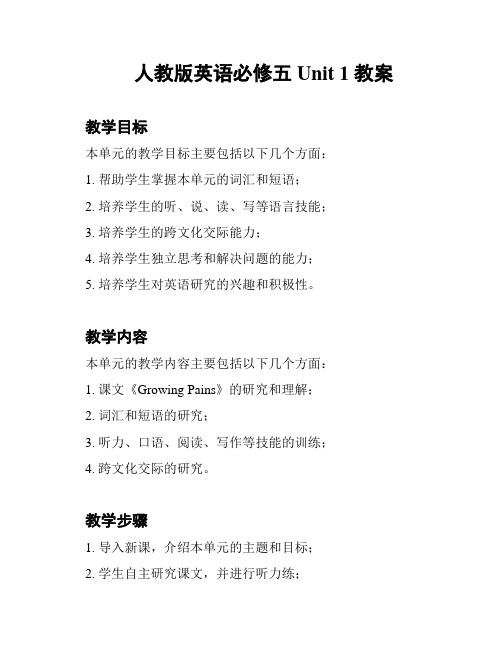
人教版英语必修五 Unit 1 教案教学目标本单元的教学目标主要包括以下几个方面:1. 帮助学生掌握本单元的词汇和短语;2. 培养学生的听、说、读、写等语言技能;3. 培养学生的跨文化交际能力;4. 培养学生独立思考和解决问题的能力;5. 培养学生对英语研究的兴趣和积极性。
教学内容本单元的教学内容主要包括以下几个方面:1. 课文《Growing Pains》的研究和理解;2. 词汇和短语的研究;3. 听力、口语、阅读、写作等技能的训练;4. 跨文化交际的研究。
教学步骤1. 导入新课,介绍本单元的主题和目标;2. 学生自主研究课文,并进行听力练;3. 进行课文的理解和讨论,引导学生思考和表达观点;4. 研究和掌握本单元的词汇和短语;5. 进行听说训练,提高学生的口语表达能力;6. 进行阅读和写作训练,培养学生的阅读理解和写作技能;7. 进行跨文化交际的研究,增进学生对英语和其他文化的认识。
教学评价本单元的教学评价主要以以下方式进行:1. 各种形式的课堂练和作业,检测学生对知识的掌握程度;2. 口语和写作表现的评价,评估学生语言运用的能力;3. 学生参与课堂讨论和发言的情况,评估学生的思维能力和表达能力。
教学资源本单元的教学资源包括以下几个方面:1. 课本《人教版英语必修五》;2. 音频材料;3. 多媒体设备;4. 教学课件和作业练册。
以上为《人教版英语必修五 Unit 1 教案》的简要内容,旨在帮助教师设计和安排本单元的教学活动。
具体的教学步骤和细节应根据实际情况进行调整和完善。
新教材高中英语UNIT5LanguagesaroundtheworldSectionⅠListeningandSpeaking教案新人教版必修第一册
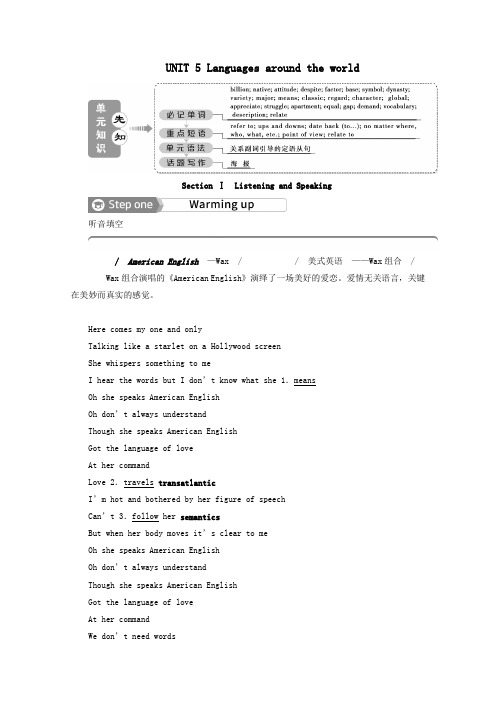
UNIT 5 Languages around the worldSection ⅠListening and Speaking听音填空/American English—Wax / / 美式英语——Wax组合/Wax组合演唱的《American English》演绎了一场美好的爱恋。
爱情无关语言,关键在美妙而真实的感觉。
Here comes my one and onlyTalking like a starlet on a Hollywood screenShe whispers something to meI hear the words but I don’t know what she 1.meansOh she speaks American EnglishOh don’t always understandThough she speaks American EnglishGot the language of loveAt her commandLove 2.travels transatlanticI’m hot and bothered by her figure of speechCan’t 3.follow her semanticsBut when her body m oves it’s clear to meOh she speaks American EnglishOh don’t always understandThough she speaks American EnglishGot the language of loveAt her commandWe don’t need wordsTo express 4.what is realWe’ve got each otherThat says everything that we feelThere’s too much damn confusionWith all this talking going round and round We’ll 5.reach our own conclusionWe’ll make connection on the common ground Oh she speaks American EnglishOh don’t always understandThough she speaks American EnglishGot the language of loveAt her command你是我的唯一说话像一个好莱坞屏幕上的明星她向我低语我听到这句话,但是我不知道她是什么意思哦,她说美式英语哦,总是不理解虽然她说美式英语爱的语言由她掌控爱跨大西洋我困惑于她的话语不能理解她的语义但是,她的身体动作对我来说很明显哦,她说美式英语哦,总是不理解虽然她说美式英语爱的语言由她掌控我们不需要言语表达什么是真实我们彼此拥有这就是我们的感觉有太多的困惑所有这些话语在脑海里绕了一圈又一圈我们会得出自己的结论我们将连接在共同点哦,她说美式英语哦,总是不理解虽然她说美式英语爱的语言由她掌控[词海拾贝]1.transatlantic[ˌtrænzət'læt Ik]adj.在大西洋彼岸的2.semantics[sI'mænt Iks]n.含义3.confusion[kən'fjuːʒ(ə)n]n.困惑Look at the following pictures, would you like to visit them? Discuss with your partners which official languages are spoken in these countries.Spain:圣家堂India:泰姬陵Germany:柏林自由女神像France:埃菲尔铁塔America:自由女神像Canada:西恩塔Britain:大本钟Russia:莫斯科红场Spain: SpanishIndia: EnglishGermany: _GermanFrance:FrenchAmerica: EnglishCanada: EnglishBritain: EnglishRussia: RussianⅠListen to a speech and tick the two languages with the most native speakers.Choose the official languages of the United Nations(UN).(教材P60) Russian Chinese Korean JapaneseSpanish Arabic English FrenchThe most native speakers: Chinese,_Spanish.The official languages of the United Nations(UN): Arabic,_Chinese,_English,_French,_Russian,_Spanish.听力材料:Exploring Languages Around the WorldTo some students, it seems that the only foreign language to learn is English.There are, however, nearly 7,000 languages in the world.After Chinese, the language with the most native language speakers isn’t English—it’s Spanish.Learning English is very useful, but it is wise to learn at least one other foreign language, if possible.There are many reasons why people learn a foreign language.Many students choose to study one of the languages that are spoken at the UN.As they think it means better job chances in the future.The UN has six official languages: Arabic, Chinese, English, French, Russian, and Spanish.They are spoken by around 2.8 billion people as their native or second language.Some students, though, choose to study a language because of family orfriends.One American girl chose to learn Danish because her grandparents were from Denmark.When she was little, her grandpa used to read letters to her in Danish from their relatives in Denmark.Another young lady started learning French because she had several friends from African countries where French is spoken.What do you think? Which other language would you choose to study and why?ⅡListen to the speech again and answer the questions.1.What is the main topic of this speech?答案:It_is_mainly_about_languages_around_the_world.2.How many languages are there in the world?答案:Nearly_7,000.3.Ho w many billion people speak the UN’s official language as their native or second language?答案:2.8_billion.4.What is the attitude of the speaker towards foreign language learning?答案:He_believes_learning_foreign_languages_is_very_useful.Listening Tips1.注意细节Before listening to the text, look through the exercises quickly and find out the key points according to the exercises.2.巧判人物关系、身份与职业人物关系、职业、身份等相关方面的听力试题要求在某一特定环境下,对说话人的身份进行推理与判断。
英语优秀教案(人教版):必修五(Unit 1 Great scientists Period 1)
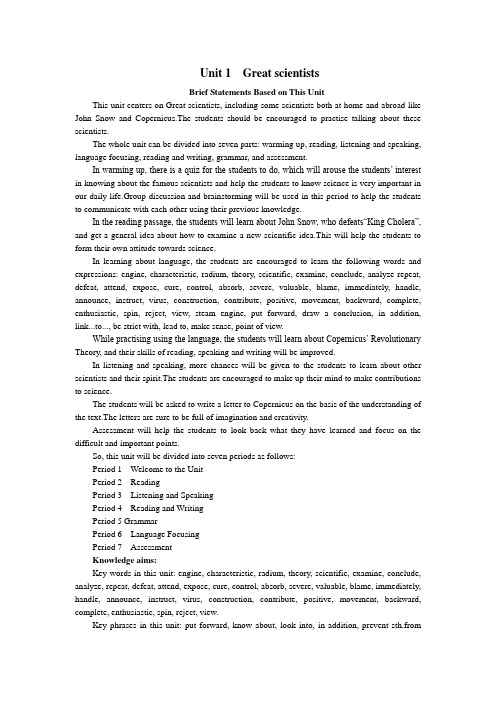
Unit 1Great scientistsBrief Statements Based on This UnitThis unit centers on Great scientists, including some scientists both at home and abroad like John Snow and Copernicus.The students should be encouraged to practise talking about these scientists.The whole unit can be divided into seven parts: warming up, reading, listening and speaking, language focusing, reading and writing, grammar, and assessment.In warming up, there is a quiz for the students to do, which will arouse the students’ interest in knowing about the famous scientists and help the students to know science is very important in our daily life.Group discussion and brainstorming will be used in this period to help the students to communicate with each other using their previous knowledge.In the reading passage, the students will learn about John Snow, who defeats“King Cholera”, and get a general idea about how to examine a new scientific idea.This will help the students to form their own attitude towards science.In learning about language, the students are encouraged to learn the following words and expressions: engine, characteristic, radium, theory, scientific, examine, conclude, analyze repeat, defeat, attend, expose, cure, control, absorb, severe, valuable, blame, immediately, handle, announce, instruct, virus, construction, contribute, positive, movement, backward, complete, enthusiastic, spin, reject, view, steam engine, put forward, draw a conclusion, in addition, link...to..., be strict with, lead to, make sense, point of view.While practising using the language, the students will learn about Copernicus’ Revolutionary Theory, and their skills of reading, speaking and writing will be improved.In listening and speaking, more chances will be given to the students to learn about other scientists and their spirit.The students are encouraged to make up their mind to make contributions to science.The students will be asked to write a letter to Copernicus on the basis of the understanding of the text.The letters are sure to be full of imagination and creativity.Assessment will help the students to look back what they have learned and focus on the difficult and important points.So, this unit will be divided into seven periods as follows:Period 1Welcome to the UnitPeriod 2ReadingPeriod 3Listening and SpeakingPeriod 4Reading and WritingPeriod 5 GrammarPeriod 6Language FocusingPeriod 7AssessmentKnowledge aims:Key words in this unit: engine, characteristic, radium, theory, scientific, examine, conclude, analyze, repeat, defeat, attend, expose, cure, control, absorb, severe, valuable, blame, immediately, handle, announce, instruct, virus, construction, contribute, positive, movement, backward, complete, enthusiastic, spin, reject, view.Key phrases in this unit: put forward, know about, look into, in addition, prevent sth.fromdoing, lead to, make sense, punish sb.for, suggest doing sth.steam engine, draw a conclusion, link...to..., be strict with, lead to, point of view.Key sentence patterns:1 But he became inspired when he thought about helping ordinary people exposed to cholera.2 He got interested in two theories explaining how cholera killed people.3 Only if you put the sun there did the movements of the other planets in the sky make sense.Grammar in this unit:Past participle used as attribute and predicativeAbility aims:1.To talk about great scientists and their great achievements.2.To guess what will be talked about in the listening materials.3.To improve their reading skills.4.To learn to use past participle as attribute and predicative.Emotion aims:To encourage the students to learn about some great scientists and their great achievements and how science helps to improve our society and change our life.Meanwhile, inspire the students to learn from the scientists and form their positive attitude towards science.Period 1Welcome to the UnitThe General Idea of This PeriodThe uni t centers on“great scientists”.This is the first period of this unit.During this period, the students should be encouraged to give their previous knowledge of some of the famous scientists, participate in the activities in class and try to get more information from the discussion.They will take part in different forms of activities, including pair work, group work, competition, and quiz.Group competition will be carried out all through the class.Words and expressions in this unit will help the students to talk about the topic“great scientists”.So at the beginning of this period, the teacher should spend some time training the students to read them and help the students pronounce them correctly.The students are encouraged to learn the new words in groups by themselves, using dictionaries and other reference books.Then more time should be given to the students to get familiar with the words and stly, several sentences will be given to the students to help them to know how to use some of the phrases.This unit is about“great scientists”, so from the very beginning, the teacher can encourage the students talk about their dreams in the future.Then the teacher can let the students brainstorm something about great scientists.The students are free to say anything that they know.The students will be quite interested in this topic.This activity gives the students a chance to express their feelings about their favorite scientist.At the same time, this activity can stir the students’ enthusiasm in science.Then the teacher can have the students match the famous scientists with their discoveries, inventions or theories, making sure that they have some common sense about some world-famous scientists.Later the students will be divided into several groups, describe one of the great scientists and let other students guess who he or she is talking about.In this way, the students should learn to organize their own sentences and express their ideas clearly.After that, the students will feel comfortable to do the quiz in the text.The students should beencouraged to give more information about these ten scientists.Meanwhile, the students’ interest in scientists and science should be cultivated.So two topic discussion questions, as well as the practice exercises are designed.The post-class activities are designed to arouse the students’ interest in science and encourage them to“DIY—do it yourself” in their daily life if they have some doubt in some areas.T eaching Important PointsHave the students discuss great scientists.Encourage the students to hold their views about their future career.Understand and learn the following words and expressions: engine, characteristic, radium, theory, scientific, examine, conclude, analyse, repeat, defeat, attend, expose, cure, control, absorb, severe, valuable, blame, immediately, handle, announce, instruct, virus, construction, contribute, positive, movement, backward, complete, enthusiastic, spin, reject, view, steam engine, put forward, draw a conclusion, in addition, link...to..., be strict with, lead to, make sense, point of view.T eaching DifficultiesWhat can we learn from the scientists?What should we do in our daily life to develop our interest and love for science?T eaching AidsCAI equipment with a Multi-media classroom and other normal teaching tools.Three Dimensional T eaching AimsKnowledge AimsLearn something about some famous scientists in the world.Know about the outstanding discoveries, inventions and theories from some well-known scientists.Try to understand and learn the important words and expressions.Ability AimsDevelop the students’ ability of speaking.Encourage the students to give more information about the great scientists.Emotional AimsEncourage the students to learn more about the great scientists and learn from them.Help the students to form the good habit in learning and encourage the students to take part in social practice.Help the students to realize that it is scientific spirit that makes those scientists successful.Encourage the students to develop their love for science.T eaching ProcedureStep 1 GreetingTeacher: Hello, everyone.Teacher: Hello, Mr.../Ms...Step 2 Lead inT: I’m very glad to see you all here.After a long holiday, all of you look energetic and happy.I hope that we will work hard together happily all through the year.I do believe that a bright future is waiting for you.We are sure to realize our dreams in the near future.By the way, I’d like to know what you would like to be in the future.Let me share your dreams.Anyone who gives your idea will get a star for your group.Ready?Go!S: I admire Y ang Liwei very much, who is a great honour to our motherland.I’d like to be an astronaut like him.T: Y eah, the spacecraft, Shenzhou V, orbited the earth 14 times in 21 hours, making China the third country to have successfully sent an astronaut into space.I hope you will realize your dream.S: I want to be a doctor.I hope I’ll be an outstanding one and be expert in finding cures for different kinds of cancers.T: That’s a good idea.There are so many patients with cancers in the world, who are suff ering a lot.Thank you!S: I want to be an English teacher like you.For one thing, I like English very much; for another, you are not only strict with us but also patient with us.Y ou are just our friends and maybe more than our friends sometimes.T: I’m really glad to hear that.It’s my great honor to be your friends and I like my job very much.S: I’d like to be an expert in environment.Y ou see, with the development of industry, our globe is seriously polluted.Dirty water, polluted air, and loud noise make our living conditions worse.I think we should leave a beautiful world to the next generation.T: Y es, someone predicted that the last drop of water in the world would be the tear of human being’s.I think all of us should pay attention to our environment, and make our contributions to improving the environment.S: I’m so interested in physics.And I have read Stephen Hawking’s A Brief History of Time twice.I hope I will be a scientist like him.As we all know, the development of our society will go hand in hand with the development of science.T: Y eah, I can’t agree with you more.Science plays an i mportant part in the development of our society.There are so many examples in the history of human beings.Ss: ...T: I’m so glad to share your dreams.Y our ambition and careful thoughts really leave a good and amazing impression on me.I like them.In this unit, you will learn something about“Great scientists”.Maybe you will know what you need in your efforts to realize your dreams after we talk about some world-famous scientists.Before we come to“Warming up”, I’d like you to come to the new words in this unit, which will help you to learn this unit.Step 3 Word puzzlesT: Open your books and turn to Page 92.Let’s read the words and expressions together.(Let the students read the words and expressions together.Help them pronounce the new words and expressions ter give them some time to practise reading and remember some easy and important ones.Give more help to those who are poor in pronunciation.) T: Here are some definitions of some of the words from this unit.Please work in pairs and match the words with their definitions.(group competition)Words Definitions or explanationsA.examine 1.general principles of an art or scienceB.repeat 2.say or do againC.theory 3.at once; without delayD.immediately 4.look at...carefully in order to learn about or from...plete 5.of great value, worth or useF.valuable 6.having all its parts; whole; finishedG.announce 7.make knownH.control e or bring to an endI.positive 9.power to order or directJ.conclude 10.quite certain or sureT: Now, let’s check the answers.A—4, B—2, C—1, D—3, E—6, F—5, G—7, H—9, I—10, J—8. Y ou have done a good job.I will give you some more minutes to go over all the words and expressions and then fill in the blanks with proper forms of some of them from this unit.1.“All roads lead to Rome, ”he encouraged me after I failed the entrance examination.2.This sentence doesn’t make any sense.3.Our English teacher is not only strict with us but also friendly to us.4.He is good-looking, apart from his nose.5.It is announced that the spacecraft, Shenzhou Ⅵ, landed on the earth successfully.6.It is not Tom but you who are to blame.7.In 1995, the Chinese government put forward a plan for“rejuvenating the nation by relying on science and education”.And it has helped Chinese scientists make m any breakthroughs.8.Have you drawn any conclusion after you read this passage?T: Well done.So much for the learning of the new words and expressions.Step 4 BrainstormingT: Now let’s come to the title of this unit Great scientists.When we talk about g reat scientists, what will come into your mind(s)?We will go on our competition.S1: Madame Curie, who got two Nobel Prizes, one for physics and the other for chemistry, is really outstanding among all the women scientists.S2: It reminds me of the great inventor named Thomas Alva Edison and one of his famous sayings“Genius is one percent inspiration and ninety-nine percent perspiration.”S3: Y es, we lead a better life now with the help of science.Without Edison, maybe now we are still living in a dark world.They really make our life easier and more comfortable.S4: I also think of one of the quotes from Albert Einstein, “Imagination is more important than knowledge.”S5: All the scientists are devoted to the career that they choose, and they set good examples to us in our work.S6: Take all the scientists for example, if we want to be successful in the future, we should not only learn something from our textbooks, but also take part in social practice and get close to nature to learn more about it.S7: I like plants very much.I just think of the two key scientists in the field of botany, Carl Linnaeus and Joseph Banks.The former one laid the foundation for the classification of plants, while the latter one also made great contributions to the development and direction of botany.Ss: ...T: I’m glad to see that you have a great deal of previous knowledge of famous scientists in the world.Step 5 Previous knowledgeT: Now let’s match some of the great scientists with their famous discoveries, inventions or theories.Let me see who is the quickest in mind and action and can get all the answers correct.Famous scientists Discoveries/Inventions/TheoriesA.Isaac Newton 1.Evolution (进化论)B.Charles Darwin 2.Discovery of Radium(镭)C.Madame Curie 3.Newton’s LawD.Albert Einstein 4.Electric bulbE.Thomas Alva Edison 5.Theory of RelativityF.Nicolaus Copernicus 6.SeismographG.Stephen Hawking7.A Brief History of TimeH.Zhang Heng8.The earth moves around the sun.(Check the answers with all the students: A—3, B—1, C—2, D—5, E—4, F—8, G—7, H—6.)T: Since you have a better understanding of some of the great scientists, let’s play a game. Please work in groups and describe one of the great scientists, and then let other students guess who you are talking about.Group 1: In the eighteenth century, there lived a great scientist who conducted a number of experiments in which he showed what electricity is.Once he did a famous kite experiment on a stormy day, and proved that lightening and electricity are the same thing.S: Benjamin Franklin.Group 2: It is said that this English gentleman was sitting in his garden one day when suddenly he was hit by a falling apple.The story is probably not true, but this man did mention that he got one of his best-known ideas while watching apples fall from a tree.His name makes you think that he was not too interested in old things.He discovered the force of gravity, and he drew up a system of how objects move.His laws for motion are still used in physics today, at least in schools and universities.S: Sir Issac Newton.Group 3:Food is what sets this great mind on fire.Rice, to be exact.This great mind has spent most of his life looking for ways to help farmers grow more rice so that all of us will have enough food to eat.He is known as the father of modern rice, but because of his long friendship with all the farmers in China, he w ould rather be known as“the farmer”.S: Y uan Longping.Group 4:He was born on 8 January 1942 in Oxford, England.He has worked on the basic laws which govern the universe.He showed that Einstein’s General Theory of Relativity implied space and time would have a beginning in the Big Bang and an end in black holes.He has three popular books published: his best seller A Brief History of Time, Black Holes and Baby Universes and Other Essays and most recently in 2001, The Universe in a Nutshell.S: Stephen Hawking.Ss: ...T: Well done.Step 6 QuizT: Y ou have already known some information about some of the great scientists.Now let’s do a quiz, trying to find out who these scientists are.Quiz Questions1.Which scientist discovered that objects in water are lifted up by a force that helps them float?2.Who wrote a book explaining how animals and plants developed as the environment changed?3.Who invented the first steam engine?4.Who used peas to show how physical characteristics are passed form parents to their children?5.Who discovered radium?6.Who invented the way of giving electricity to everybody in large cities?7.Who was the painter that studied dead bodies to improve his painting of people?8.Who invented a lamp to keep miners safe underground?9.Who invented the earliest instrument to tell people where earthquakes happened?10.Who put forward a theory about black holes?Check the answers with the students.1.Archimedes2.Charles Darwin3.James Watt4.Gregor Mendel5.Madame Curie6.Faraday7.Leonardo davinci8.Humphrey Davy9.Zhang Heng 10.Stephen HawkingT: Please work in groups and have a discussion to find as much information as possible about these ten great scientists.(The teacher had better join in the discussion and give them some guidance whenever necessary.After the discussion, ask some students to give a short report about what the group have discussed.)(Refer to the information about these scientists below, and various answers are possible.) Step 7 PracticeT: Today we have learned a lot about great scientists in the world.We can learn from them to live our dreams.And we teachers are too willing to help you.In your opinion, what should our school /teachers/students do to tap the students’ potential?S: Our school should give the students more chances to take part in social practice.S: Our teachers should help the students use their imaginations.S: We students should solve the problems on our own.(Ask more students to give their opinions.The teacher should encourage them, join them, praise them, and make comments on their ideas.)Step 8 Discussion (Group Competition)T: Y our ideas are so wonderful and amazing.I admire them very much.Now let’s come to our topic.Topic 1: What can you learn from these scientists?Topic 2: What qualities should we have to be a successful man?(Give the students several minutes to have a discussion.Then let them have a group competition.)Step 9 Summing upT: In this period, we have talked a lot about great scientists.Y ou have a lot of previous knowledge and you are full of imagination and creativity.Those scientists set good examples to us.And I think all of us are happy about learning more of them.After class, it’s better to read some books about them and you can surf the Internet to get more information.And I’d like you to ma ke a“Scientists Album”in the following week.The Design of the Writing on the BlackboardUnit 1Great scientistsPeriod 1Welcome to the UnitBrainstormingResearch and ActivitiesDIY1.Cover a glass of water with a piece of thick paper.Put one hand on the paper and turn the glass upside down.Slowly take your hand away.What happens?Why?2.Fill one glass with fresh water and another glass with salt water. Put an ice cube in each glass.What happens?Why?3.Find out as many famous sayings from those scientists as possible.Reference for T eaching1.Charles Darwin was born in Shrewsbury(shropshire) to a moderately wealthy family with a strong intellectual heritage.His grandfather, Erasmus Darwin, was a physician, poet and biologist who laid some of the gr oundwork for the grandson’s revolutionary ideas.Charles attended Christ’s College at Cambridge with initial thoughts of entering the clergy, but soon took up studies in biology, zoology and geology.From 1831 to 1836, he served as a naturalist aboard the HMS Beagle on its scientific mission to South America and the Pacific.Back in England, he published a series of scientific treatises which established his reputation as one of the prominent thinkers of his day.From 1842 onwards, he lived on a country estate in Kent and pursued his studies among its gardens and livestock.By 1844, he had written the initial draft of his groundbreaking treatise on evolution and natural selection.However, he left this work unpublished for several years, preferring to refine and elaborate its core ideas.In 1858, he read a forthcoming paper by a fellow scientist Alfred Russell Wallace whose thesis closely paralleled Darwin’s own unpublished ideas, an event which pushed Darwin to go public with his own research.Both Wallace’s and Darwin’s papers were presented to the Linnean Society in a famous July, 1858 meeting. Darwin published The Origin of Species by Means of Natural Selection in 1859, sparking decades of contentious debate which ultimately led to the universal scientific recog nition of Darwin’s thesis.In later years, he developed his ideas further in monographs on different types of plant and animal life.Notes:Shrewsbury: 什鲁斯伯里[英国英格兰西部城市]physician: 内科医生(注意区分physicist, 物理学家)revolutionary: 创新的HMS: (英国)皇家海军舰船(Her/His M ajesty’s Ship)treatises: 论文2.Stephen William Hawking was born on 8 January 1942 (300 years after the death of Galileo) in Oxford, England.His parents’ house was in north London, but during the Second World WarOxford was considered a safer place to have babies.When he was eight, his family moved to St Albans, a town about 20 miles north of London.At eleven Stephen went to St Albans School, and then on to University College, Oxford, his father’s old college. Stephen wanted to do Mathematics, although his father would have preferred medicine.Mathematics was not available at University College, so he did Physics instead.After three years and not very much work he was awarded a first class honours degree in Natural Science.Stephen then went on to Cambridge to do research in Cosmology, there being no-one working in that area in Oxford at the time.His supervisor was Denis Sciama, although he had hoped to get Fred Hoyle who was working in Cambridge.After gaining his Ph.D.he became first a Research Fellow, and later on a Professorial Fellow at Gonville and Caius College.After leaving the Institute of Astronomy in 1973 Stephen came to the Department of Applied Mathematics and Theoretical Physics, and since 1979 has held the post of Lucasian Professor of Mathematic s.The chair was founded in 1663 with money left in the will of the Reverend Henry Lucas, who had been the Member of Parliament for the University.It was first held by Isaac Barrow, and then in 1663 by Isaac Newton.Stephen Hawking has worked on the basic laws which govern the universe.With Roger Penrose he showed that Einstein’s General Theory of Relativity implied space and time would have a beginning in the Big Bang and an end in black holes.These results indicated it was necessary to unify General Relativity with Quantum Theory, the other great Scientific development of the first half of the 20th Century.One consequence of such a unification that he discovered was that black holes should not be completely black, but should emit radiation and eventually evaporate and disappear.Another conjecture is that the universe has no edge or boundary in imaginary time.This would imply that the way the universe began was completely determined by the laws of science.His many publications include The Large Scale Structure of Spacetime with G F R Ellis, General Relativity: An Einstein Centenary Survey, with W Israel, and 300 Y ears of Gravity, with W Israel.Stephen Hawking has two popular books published: his best seller A Brief History of Time, and his later book, Black Holes and Baby Universes and Other Essays.Professor Hawking has twelve honorary degrees, was awarded the CBE in 1982, and was made a Companion of Honour in 1989.He is the recipient of many awards, medals and prizes and is a Fellow of The Royal Society and a Member of the US National Academy of Sciences.Stephen Hawking continues to combine family life (he has three children and one grandchild), and his research into theoretical physics together with an extensive programme of travel and public lectures.3.Humphry Davy, a woodcarver’s son, was born in Penzance in 1778. After being educated in Truro, Davy was apprenticed to a Penzance surgeon.In 1797 he took up chemistry and was taken on by Thomas Beddoes, as an assistant at his Medical Pneumatic Institution in Bristol.Here he experimented with various new gases and discovered the anesthetic effect of laughing gas (nitrous oxide).Davy published details of his research in his book Researches, Chemical and Philosophical (1799).This led to Davy being appointed as a lecturer at the Royal Institution.He was a talented teacher and his lectures attracted large audiences.In 1806 Davy published On Some Chemical Agencies of Electricity. The following year he discovered that the alkalis and alkaline earths are compound substances formed by oxygen unitedwith metallic bases.He also used electrolysis to discover new metals such as potassium, sodium, barium, strontium, calcium and magnesium.Davy was now considered to be Britain’s leading scientist and in 1812 was knight ed by George Ⅲ.With his assistant, Michael Faraday, Davy travelled abroad investigating his theory of volcanic action.In 1815 Humphry Davy invented a safety lamp for use in gassy coalmines, allowing deep coal seams to be mined despite the presence of firedamp (methane).This led to some controversy as George Stephenson, working in a colliery near Newcastle, also produced a safety lamp that year.Both men claimed that they were first to come up with this invention.One of Davy’s most important contributions to history was that he encourage manufacturers to take a scientific approach to production.His discoveries in chemistry helped to improve several industries including agriculture, mining and tanning.Sir Humphry Davy died in 1829.4.Leonardo da Vinci(b.1452, Vinci, Republic of Florence [now in Italy]—d.May 2, 1519, Cloux, Fr.), Italian painter, draftsman, sculptor, architect, and engineer whose genius, perhaps more than that of any other figure, epitomized the Renaissance humanist ideal.His Last Suppe (1495-1497) and Mona Lisa (1503-1506) are among the most widely popular and influential paintings of the Renaissance.His notebooks reveal a spirit of scientific inquiry and a mechanical inventiveness that were centuries ahead of his time.5.Madam Curie is a French professor of physics.She was born in Poland in 1867.In 1891 she went to study in Paris University because at that time women were not admitted to universities in Poland.When she was studying in Paris, she lived a poor life, but she worked very hard.In 1895 she married Pierre Curie, and then they worked together on the research into radioactive matter.They discovered two kinds of radioactive matter—polonium and radium.In 1904 she and her husband were given the Nobel Prize for physics.In 1906 Pierre died, but Marie went on working.She received a second Nobel Prize for Chemistry in 1911.So she became the first scientist in the world to win two Nobel Prizes.6.James Watt: British engineer and inventor who made fundamental improvements in the steam engine, resulting in the modern, high-pressure steam engine (patented 1769).7.Gregor Mendel was an Austrian botanist and founder of the science of genetics.Through years of experiments with plants, chiefly garden peas, he discovered the principle of the inheritance of characteristics through the combination of genes from parent cells.8.Archimedes: Greek mathematician, engineer, and physicist.Among the most important intellectual figures of antiquity, he discovered formulas for the area and volume of various geometric figures, applied geometry to hydrostatics and mechanics, devised numerous ingenious mechanisms, such as the Archimedean screw, and discovered the principle of buoyancy.9.Michael Faraday (September 22, 1791—August 25, 1867) was a British scientist(a physicist and chemist) who contributed significantly to the fields of electromagnetism and electrochemistry. He also invented the earliest form of the device that was to become the Bunsen burner, which is used almost universally in science laboratories as a convenient source of heat.Michael Faraday was one of the great scientists in history.Some historians of science refer to him as the greatest experimentalist in the history of science.It was largely due to his efforts that electricity became a viable technology.The SI unit of capacitance, the farad(symbol F) is named after him.。
人教版高中英语必修五第一单元课件
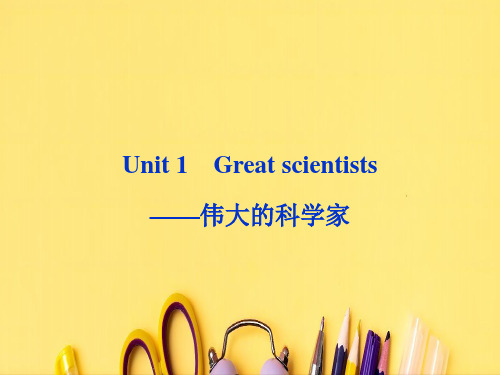
Unit 1 Great scientists——伟大的科学家
4 . prevent...from doing sth. 防 止 / 阻 止 ……做某事; suggest(建议)+宾语从句 _T_o__p_r_e_v_e_n_t _th__is_f_r_o_m__h_a_p_p_e_n_i_n_g__(为防 止这种情况发生)again,John Snow suggested that the source of all the water supplie _b_e_e_x_a_m__i_n_e_d___(被检测).
解析:选B。考查非谓语动词。根据 语境可知,felt与protect之间是被动关 系,排除选项A和C;和父亲一起的徒 步旅行已经结束,排除选项D。
栏目 导引
Unit 1 Great scientists——伟大的科学家
3 . (2012·北 京 东 城 期 末 )Lady Gaga
has put off her concerts because of the
栏目 导引
Unit 1 Great scientists——伟大的科学家
10.____b_e__a_g_a_in_s_t____ 反对 11.__(_b_e_)_s_tr_i_c_t_w_i_t_h_.._. 对……严格的 12.__b_e_t_o_b_l_a_m__e_____ 应受责备
栏目 导引
Unit 1 Great scientists——伟大的科学家
Unit 1 Great scientists ——伟大的科学家
栏目 导引
Unit 1 Great scientists——伟大的科学家
基础盘点自测自评
核心单词
1.The writer was so ___a_b_so_r_b_e_d___ ( 专心于)in her work that she didn’t notice Jim enter the room.
必修五Unit1John_Snow_Defeats_King_Cholera_教学设计
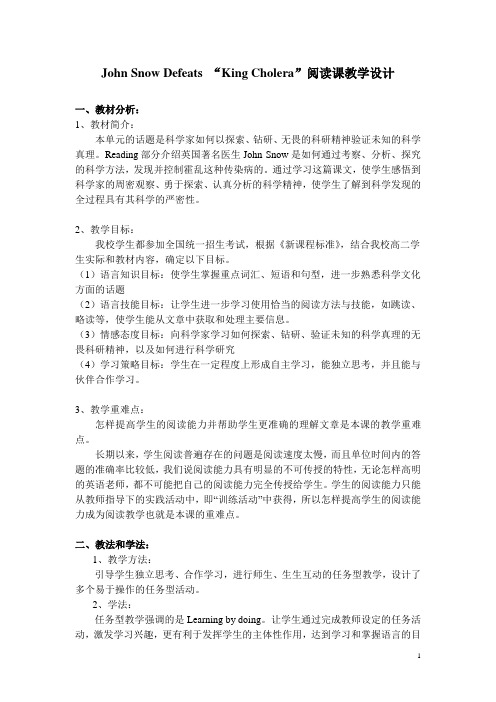
John Snow Defeats “King Cholera”阅读课教学设计一、教材分析:1、教材简介:本单元的话题是科学家如何以探索、钻研、无畏的科研精神验证未知的科学真理。
Reading部分介绍英国著名医生John Snow是如何通过考察、分析、探究的科学方法,发现并控制霍乱这种传染病的。
通过学习这篇课文,使学生感悟到科学家的周密观察、勇于探索、认真分析的科学精神,使学生了解到科学发现的全过程具有其科学的严密性。
2、教学目标:我校学生都参加全国统一招生考试,根据《新课程标准》,结合我校高二学生实际和教材内容,确定以下目标。
(1)语言知识目标:使学生掌握重点词汇、短语和句型,进一步熟悉科学文化方面的话题(2)语言技能目标:让学生进一步学习使用恰当的阅读方法与技能,如跳读、略读等,使学生能从文章中获取和处理主要信息。
(3)情感态度目标:向科学家学习如何探索、钻研、验证未知的科学真理的无畏科研精神,以及如何进行科学研究(4)学习策略目标:学生在一定程度上形成自主学习,能独立思考,并且能与伙伴合作学习。
3、教学重难点:怎样提高学生的阅读能力并帮助学生更准确的理解文章是本课的教学重难点。
长期以来,学生阅读普遍存在的问题是阅读速度太慢,而且单位时间内的答题的准确率比较低,我们说阅读能力具有明显的不可传授的特性,无论怎样高明的英语老师,都不可能把自己的阅读能力完全传授给学生。
学生的阅读能力只能从教师指导下的实践活动中,即“训练活动”中获得,所以怎样提高学生的阅读能力成为阅读教学也就是本课的重难点。
二、教法和学法:1、教学方法:引导学生独立思考、合作学习,进行师生、生生互动的任务型教学,设计了多个易于操作的任务型活动。
2、学法:任务型教学强调的是Learning by doing。
让学生通过完成教师设定的任务活动,激发学习兴趣,更有利于发挥学生的主体性作用,达到学习和掌握语言的目的。
3、教具:使用多媒体平台、导学案、教材,以扩大学生知识面和求知欲。
人教版高中英语必修五Unit 1 Great scientists 1.1
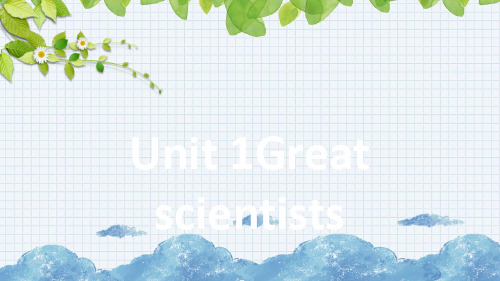
Section Ⅰ Warming Up,Pre-
一二三 四五
一、词义匹配
A
B
1.suspect a.to tell people something about a decision,plans,etc.
2.blame b.to deal with a situation,or a person
Unit 1Great scientists
【文章导语】 Have you heard of Newton,a famous scientist?There are many interesting stories about him.Here is one.
你听说过著名科学家牛顿吗?关于他,有许多有趣的故事。下面 就是其中之一。
adj.受污染的
一二三 四五
四、阅读课文JOHN SNOW DEFEATS “KING CHOLERA”,回
答下列问题
1.According to John Snow’s view,
.
A.Queen Victoria suffered a lot from bad health
B.a cure had been found for cholera before his time
C.cholera’s cause had to be discovered in order to control it
D.thousands of terrified people knew what they should do
答案:C
一二三 四五
2.Which of the following theories did John Snow believe in?
高中英语人教必修五unit1GreatScientists全单元优质教案
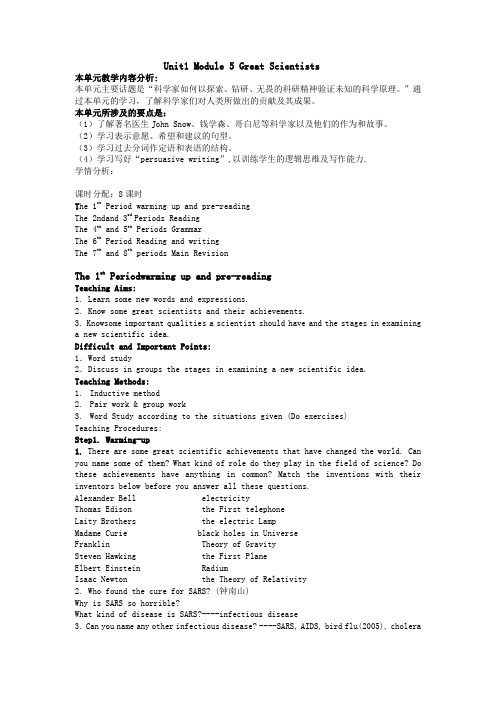
Unit1 Module 5 Great Scientists本单元教学内容分析:本单元主要话题是“科学家如何以探索、钻研、无畏的科研精神验证未知的科学原理。
”通过本单元的学习,了解科学家们对人类所做出的贡献及其成果。
本单元所涉及的要点是:(1)了解著名医生John Snow、钱学森、哥白尼等科学家以及他们的作为和故事。
(2)学习表示意愿、希望和建议的句型。
(3)学习过去分词作定语和表语的结构。
(4)学习写好“persuasive writing”,以训练学生的逻辑思维及写作能力.学情分析:课时分配:8课时T he 1st Period warming up and pre-readingThe 2ndand 3rd Periods ReadingThe 4th and 5th Periods GrammarThe 6th Period Reading and writingThe 7th and 8th periods Main RevisionThe 1st Periodwarming up and pre-readingTeaching Aims:1. Learn some new words and expressions.2. Know some great scientists and their achievements.3. Knowsome important qualities a scientist should have and the stages in examininga new scientific idea.Difficult and Important Points:1.Word study2.Discuss in groups the stages in examining a new scientific idea.Teaching Methods:1.Inductive method2.Pair work & group work3.Word Study according to the situations given (Do exercises)Teaching Procedures:Step1. Warming-up1. There are some great scientific achievements that have changed the world. Can you name some of them? What kind of role do they play in the field of science? Do these achievements have anything in common? Match the inventions with their inventors below before you answer all these questions.Alexander Bell electricityThomas Edison the First telephoneLaity Brothers the electric LampMadame Curie black holes in UniverseFranklin Theory of GravitySteven Hawking the First PlaneElbert Einstein RadiumIsaac Newton the Theory of Relativity2. Who found the cure for SARS? (钟南山)Why is SARS so horrible?What kind of disease is SARS?----infectious disease3. Can you name any other infectious disease? ----SARS, AIDS, bird flu(2005), choleraH1N1,HFMD(手足口病)Step2. Pre-reading1. Cholera may be rare nowadays except in some poor areas, but back in the 1830s-1840s, it was probably No.1 killer in the world. There were four outbreaks of cholera in the 1830s and 1840s, which killed many thousands of people in the industrial cities of England. In 1854 on August 31st “the most terrible outbreak of cholera which ever occurred in the kingdom” began. It was so violent and sudden that 127 people around Broad Street died in the first three days. And then a famous physician John Snow discovered the source of the disease and since then Cholera was finally brought under control.2. How did he solve the problem of cholera? Actually, he followed a scientific procedure to carry out his scientific research. The whole procedure is made up of 7 steps. Can you put them in a right order?Draw a conclusion Think of a method Collect results Make up a question Find a problem Analyze the results Repeat if necessaryStep 3 SummaryStep 4 Homework Assignment1.Read the passage John Snow Defeats “King Cholera”.2. Learn the new words by heart and prepare for tomorrow’s dictation.课后反思:The 2ndand 3rd Periods ReadingTeaching aims:1. Learn some new words and expressions.2. Improve the students’ reading skills.3. Know how to prove a new idea in scientific research.Difficult and Important Points:(1)Reading comprehension(2)What did John Snow do to prove a new idea in scientific research?Teaching Methods:1. Group work2. Competition3. Illustration4. Deductive MethodTeaching Procedures:Step 1Lead inBackground introduction to John SnowJohn Snow (1813-1858) was born and worked as a doctor in Great Britain. He was originally an anesthetist(麻醉师).He was so famous that he became the doctor for Queen Victoria at the births of her many children.Four outbreaks of cholera in the 1830s and 1840s killed many people in England. In 1854, “the most terrible outbreak of cholera which ever occurred in the kingdom” began. It was so violent and sudden that 127people died in the first three days. Step 2 Skimming and ScanningMore questions are given to get the general ideas of this passage and some obvious facts.Who defeats “King Cholera“? John SnowWhat happened in 1854? Cholera outbreak hit London.How many people died in 10 days? 500Why is there no death at No. 20 and 21 Broad Street as well as at No. 8 and 9 Cambridge Street?These families had not drunk the water from the Broad Street pump.Step 3 Reading for details1. Why couldn’t the cholera be under control at first?Neither its cause, not its cure was understood.2. Which theory did John Snow believe in?People absorbed cholera into their bodies with their meals.3. John Snow finally proved the theory he believed by ________.gathering information with the help of a maplooking into the source of the water for Broad Street and Cambridge Street Separating those who suffered cholera from those who didn’tBoth A and B (right choice)4. To prevent the cholera from spreading again, what did John Snow do? Suggested that the source of all water supplies be examine. Suggested that new methods of dealing with polluted water be found. Instructed the water companies not to expose people to the polluted water anymore.Step 4 Summing up: Read the passage silently and quickly and match the stages ofThe same with above:Find a problem draw a conclusion Think of a method Collect results Make up a question Analyze the results Repeat if necessaryParagraph 1: Introduction of John Snow and CholeraParagraph 2: Two theoryParagraph 3-5: Study of the breakout in 1854Paragraph 3: Think of a method: Test two theoryCollect the result: Mark the deathAnalyze the result: Reason for death and no deathParagraph 4: Analyze the result: Find the resource of the waterParagraph 5: Repeat if necessary: Find more evidence.Draw a conclusion: Cholera was spread by germPolluted water carried cholera Paragraph 6: Prevention of CholeraStep 5 Retell the passage (文章缩写仅供参考)Provide ss with a summary with some blanks. Let them retell the passage as well as pay attention to some important words.Read the passage again and fill in the blanks:John Snow was a well-known ____ in London in the ___ century. He wanted to find the ______ of cholera in order to ______ it. In 1854 when a cholera ____ out, he began to gather information. He _____ on a map where all the dead people had lived and he found that many people who had drunk the dirty water from the ______ died. Sohe decided that the polluted water carried cholera. He suggested that the _____ of all water supply be _______ and new methods of ________ with polluted water be found. Finally, “King Cholera” was defeated.Key: (见课文和教师用书)Step 6Language learning1.So many thousands of terrified people died every time there was an outbreak. 每当(疾病)突发时,总有成千的人死去【句型剖析】 1)本句是一个复合句,every time引导的是一个时间状语从句,意思是“每当……”,相当于“when”。
- 1、下载文档前请自行甄别文档内容的完整性,平台不提供额外的编辑、内容补充、找答案等附加服务。
- 2、"仅部分预览"的文档,不可在线预览部分如存在完整性等问题,可反馈申请退款(可完整预览的文档不适用该条件!)。
- 3、如文档侵犯您的权益,请联系客服反馈,我们会尽快为您处理(人工客服工作时间:9:00-18:30)。
Book 5 Unit 1 Great ScientistsA general review of Unit 1Period 1 Word study, Warming up, pre-readingPeriod 2 Reading (P2)Period 3 Language points, learning about languagePeriod 4 Using language( listening), GrammarPeriod 5 Listening & Reading (p44-45)Period 6 Reading & writing (p6)Period 7 Exercises & SummaryPeriod 1Pre-class task:1. Preview new vocabulary of Unit 1, and especially pay attention to the pronunciation of the new word2. Finish the quiz in Warming up( p1) in groups of four by referring to books or surfing the net.Step 1 Learning GoalsGet Ss to go through the summing up form on p 8 in order to have a general idea of the learning goals of Unit 1Step 2 Word Study1. (Pair work) Get Ss to learn the new words and phrases on p92 within 3 mins, by reading them aloud to each other to make sure that they can pronounce the words correctly---- Get Ss to read aloud the words in pairs by turns, e.g. 1 pairs read 4 words then go to next pair2. Practice3.1)Mrs. White bought a pan with a long ________. (handle)2)The pollution is so ________ that we have to take some measures to stop it.(severe)3)He has a big nose that is a ________ of his family. (characteristic)4)Water and salt are ________ into our blood stream every day. (absorbed)5)If a doctor or a medical treatment ________ someone’s illness, they make theperson well again. (cure)6) A ________ is a kind of germ that can cause disease. (virus)Step 3. Warming up(Group competition) Check the answers to the quiz to find out which group know the most . Show pictures to introduce some scientists while Ss giving the correct answers-- congratulations to the winning groupStep 4 Pre-reading1. (Pair work) What five most important qualities do you think a scientist should have? Give reasons.clever/talented strict patient creative determined/strong-willed positivehonest energetic intelligent/hard-working ambitious careful co-operativeconfident brave2. (Group work) Ex2, p1Do you know how to prove a new idea in scientific research? Discuss in groups the stages in examining a new scientific idea. What order would you put them in?Draw a conclusion Think of a method Collect results Make up a question Find a problem Analyse the results Repeat if necessaryStep 5. Summary1.Seeing much, suffering much, and studying much are three pillars (支柱,要素) of learning.2.learning without thought is a labour lost; thought without learning is perilous(危险的)3. To know the disease is half the cure. 找出病根等于医治了一半。
.Step 6 Homework1. Preview the reading passage John Snow Defeats “King Cholera”(p2)2. Speaking task (p46) write some key words to the Qs to help your talk on your book and prepare to introduce the scientist you admire most to the class3. Read notes ①--⑨to Unit 1, p76-774. Listening exercise P41,Ex 1&2Period 2Step 1 Homework checking p41 ListeningStep 2 Lead in1.Invite 2-3 Ss to introduce the scientists they admire most to the class2. Background introduction to John SnowJohn Snow (1813-1858) was born and worked as a doctor in Great Britain. He was originally an anesthetist(麻醉师).He was so famous that he became the doctor for Queen Victoria at the births of her many children.Four outbreaks of cholera in the 1830s and 1840s killed many people in England. In 1854, the most terrible outbreak of cholera which ever occurred in the kingdom began. It was so violent and sudden that 127people died in the first three days.3.Give information of the deadly disease cholera1) What infectious diseases do you know? (AIDS, SARS, H5N1,pig-borne disease 猪链球菌)4. Make up a questionWhat was the cause of this disease ? How did John Snow find it out?Get Ss to imagine and describe How John Snow defeat cholera by making use of the key words cholera, outbreak, severe, deadly, infectious, examine, expose, analyse, control, cure, defeatStep 3 Reading1.Fast reading : Read the text quickly and find out the main idea of each paragraphPara 1: the problem Para 2: the cause----two theories Para 3: the methodPara 4: the discovery Para 5: the result and conclusion Para 6: the suggestion2.Show pictures of water pump and teach handle3.Careful reading: Read the text carefully and fill in the chart (Ex 1, p3)Step 4 Discussion1.(Group work) Discuss how John Snow investigate cholera. Put the stages in examining the disease in the right order.Draw a conclusion Think of a method Collect results Make up a question Find a problem Analyse the results Repeat if necessary2. P3, Ex2, Q3: Do you think John Snow would have solved this problem without the map? Give your reasons.Step VI. Homework1.Finish P4, Ex 1,2(on SB) Ex3 make sentences on exercisebook (make one’s way to, make upone’s mind, make sure, make room for)2.Find out the phrases according to the Chinese (part 1 on the paper for language points)3.Retell the story John Snow Defeats “King Cholera” by following the 7 steps on p14. Read notes to Unit 1, p78-79, find out some difficult points while reading the textPeriod 3Step 1 Homework checking1.Retelling: get 2 Ss to retell the story John Snow Defeats “King Cholera”by following the 7steps2.P4, Ex 1,2Step 2 Language points1. Ss give the phrases and expressions according to the Chinese T gives2. Ss raise Qs on some difficult points they found while reading the text3.Deal with the Language points exercises with the help of the notes on the paperStep 3 Homework1. Finish P42, Ex 1, P43, Ex 3, 4, P44,Ex 12. Finish P4, “Discovering useful structures” Ex1 (explain)3. Preview the notes of Grammar on the paper for language points4. Review the words for tomorrow’s dictation.Period 4Step1 DictationStep 2 Homework checkingP42, Ex 1, P43, Ex 3, P44 Ex1Step 3 Grammar1. Look at the sentences carefully. Pick out the attributes& predicative ofthe sentences. Give reasons for why you divide them into these groups.1) I was angry with him for keeping me waiting so long.2) She is a beautiful young lady.3) He got worried about losing the money.4) Sally was so excited at the good news.5) So many thousands of terrified people died.2. Discovering Useful Structures ( P4 )(1).Find more examples in the reading passage where the past participle is used as attribute and predicative.1) Doctor John Snow was a well-known doctor in London. (attribute)2) John Snow told the astonished people in Broad Street. (attribute)3) He got interested in the two theories.(predicative)4) Neither its cause, nor its cure was understood. (predicative)(2).Go over the Grammar rules on the paper for language points and emphasize the focus(3) Finish Ex 2 on P 5 “Complete the table with phrases that have the same meaning”(in halves, Ss should finish half of the exercises and listen to the others for the answers to the rest exercises)(4) ExercisesStep 4. Listening ( P5—6 )Using language Ex1Step 5SummaryStep 6 Homework1. Finish P44, Using structures Ex.2 , P5, Ex 3 (on SB)2.Try P45, Ex 4 (explain)3.Preview reading P45-46Period 5Step 1 Homework checkingP5, Ex 3., P44, Using structures Ex.2Step 2 Lead inP45, Ex 4 “Can you solve the problem?”T: Do you know why you c an’t go over it without missing any points or going over a line twice?Step 3 Listening P441.“Who is Leonhard Euler? What achievement has he made?” Then go over Ex.1 and teachnew words2.Listen to the tape twice1st listening: find out the answers to Ex3 and Ex 2-- check Ex32nd listening: finish Ex 2Step 4 Reading-----Finding The Solution ( P45 )1. BackgroundLeonhard Euler (1707-1783)Born: 15 April 1707 in Basel, SwitzerlandDied: 18 Sept 1783 in St Petersburg, RussiaEuler was a famous mathematician in the eighteenth century, he introduced a new branch of mathematics called topology. It is a form of geometry that help you understand things by turning them into diagrams.2.Reading comprehending1) Q: What is Euler path?Can you go over it without missing any points or going over a line twice?A AD D F EB C BCEuler said, “If a figure has more than two odd points, you cannot go over it without lifting your pencil from the page or going over a line twice.”2) underline some useful phrases3) Try to prove Euler ruleStep 5 Play a Puzzle game (Work out puzzles on 46 or leave it as HW)Step 6 Homework1.P42 Ex. 2 Translation (on exercisebook)2. Review the words for tomorrow’s dictation.3.find out information of Copernicus( Who is he? What achievement did he make? When? …)and find out the names of the nine planets of the solar system. You can try this following website:/Literature/Biographies/Scienc e/Copernicus.htm/colls/special/featureditem/copernicusPeriod 6Step 1. Warming up1.Get 1-2 Ss to report to the class information of CopernicusF( Who is he? What achievement did he make? When? …)2. BackgroundNicolaus Copernicus was a Polish astronomer (1473-1543). Born in Torun, he began his university studies in Krakow in 1491, where he studied canon law and Latin and Greek classics. However he also had an interest in mathematics and astronomy. After obtaining his degree of Doctor of Canon Law (教会法规博士学位)in Italy in 1503, Copernicus returned home to Warmia in Poland to serve as Canon (=priest) .In 1530, Copernicus completed his great work De Revolutionibus(《天体运行论》).Copernicus knew that these findings would lead him into trouble with the Roman Catholic Church (罗马天主教教徒), so he wasin no hurry to publish his theory. He only published it as he lay dying in 1543.Though Copernicus did not live to hear of its extraordinary impact, the book which first suggested that the Sun, not the Earth, is the centre of the universe is now recognized as one of the most influential scientific works of all time.3 Get Ss to give the names of the nine planets of the solar system .Mercury Venus Earth Mars Jupiter Saturn Uranus NeptunePlutoCan you use a good method to memorize them ?M y V ery E asy M ethod: J ust S et U p N ineP lanetsStep 2 Reading ----Copernicus’ Revolutionary Theory (P6-7)1. Fast reading: Listen to the tape, and find out the answers to the questions.1). What did Copernicus think was the center of the solar system?2). When did Copernicus publish his theory?3) Why didn’t Copernicus publish his theory before he died?2. Reading comprehensionP7. e the reading to help you draw the two theories of the universe.Before Cope rnicus’ theoryA diagram showing the solar system with the earth at its centreShowing Copernicus’ theoryA diagram showing the solar system with the sun at its centerStep 3. Persuasive writing1. Please refer to P8 Learning Tip2. Writing Task: P7. Ex3. (write a short letter asking Copernicus to publish his ideas so everyone can read them)Go over the steps and try to follow them (P7-8)3. Offer a period of time for Ss to write a draft4. Get several Ss to read their writing to the class, T gives some comments5.Give a sample writingOne possible version:Dear Nicolaus Copernicus,I am a student studying astronomy and I would very much like to read your new theory about the solar system. I hope you will publish it for several reasons.I understand the problems with the present theory. The way the planets move is not whatyou would expect if the earth was the certre of the universe. It is also odd that the brightness of some stars seems to change. So I agree with you that we need a new theory.I know your observations have been very carefully carried out over many years. Now you must have the courage to publish them. Science can never advance unless people have the courage of their beliefs. I know you worry about what will happen if you publish your new theory. No matter how people oppose it, time will show if your ideas are right or wrong.So I hope you will feel you can publish your new theory.Yours sincerely,Zhang HuaStep 4. Homework1 Revise the composition and hand it in tomorrow.2 Revise the language points for tomorrow’s quiz.Period 7Step 1 QuizFinish then check the answersStep 2 Exercise checkingStep 3.Talking (P41)Imagine you are going to meet your pen-friend at the weekend party. You both need a description of the other so you can recognize each other when you meet. Now ring your pen-friend to sort out the necessary information.(Pair work) Making a telephone call---refer to the expressions on P42Step 4. Summary to Unit 1Finish the summing up chart on P8。
